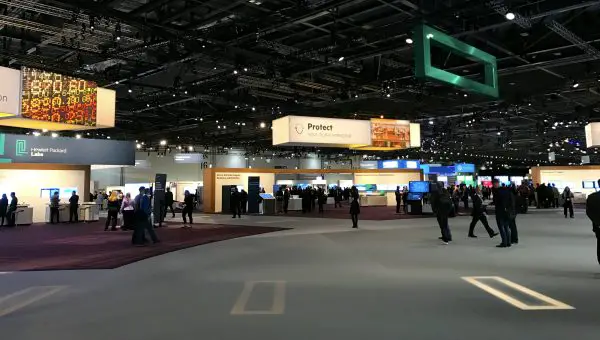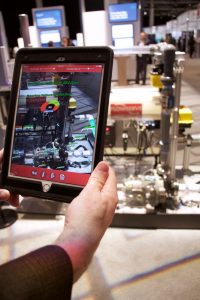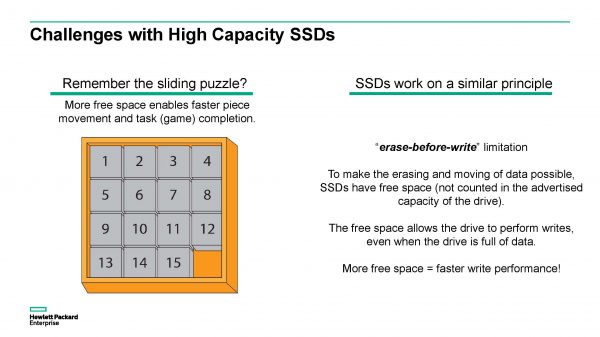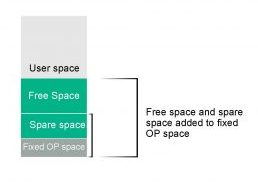Aruba Networks co-founder Keerti Melkote thinks the future of workspaces is all about augmenting technologies and the Internet of Things to assist workers to get their jobs done. During the Day 2 keynote at HPE Discover, Melkote shared a model of the intelligent workspace while sharing the stage with Özer Dondurmacioglu, general manager of Meridian apps for Aruba, to show off the capabilities.
Melkote unpacked three key areas that are required for an intelligent workspace – 1) pervasive and ubiquitous WiFi, 2) Security and 3) Location.
WiFi is the critical building block and Melkote walked attendees through a brief history of the company and WiFi capabilities. Wireless has gone from a convenience to a requirement in most offices, as workers become more collaborative and transitional in their workspace. Workers are no longer tied to a specific desk or workspace and instead need to be able to work wherever they are. Enabling technologies like Skype for Business and soft phone capabiltiies allow works to be decoupled from their desks and work anywhere. Today, he says, the demands of the wireless network are greater than ever with the introduction of mobile devices – like phones and tablets – in addition to the traditional laptops.
Even in his historical reflection, Melkote acknowledged the most companies realized the need for security as they extended their networks outside of their physical walls when first deploying WiFi. The RF signal bleeds past your physical barriers and could allow unwanted intruders onto your network – so security is a key component of any intelligent office solution. But beyond wireless, the Internet of Things has changed the requirements for network security – with the introduction of additional devices that are network connected. From thermostats to lighting controls, IoT devices are increasingly common, however, each of these devices should have a specific communication pattern that it adheres to. HPE wants to tap into those expected behaviors and be able to apply policies around where these IoT devices can communicate and close the gate for any potential hacker exploiting these devices.
HPE introduced a new Universal Profiler product that allows full discovery and classification of network devices. Once a network device is found, it is fully inspected and identified and a set of policies can be set around it. When a device acts unexpectedly, it can be shutdown automatically. Temperature control systems may only need to interact with building management systems, so if Universal Profiler sees it talking to database servers and other devices, it can signal the problem and stop it.
The third key point of an intelligent workspace are location based services. While GPS works great in exterior situations, its useless in most interior spaces. However, Aruba Networks has previously shown off its location services utilizing Aruba Beacons to be able to do proximity based location services in interior spaces. By deploying Aruba Beacons, users can give the same ‘blue dot’ experience the users get on maps with their smartphone in exterior settings.
In previous demos/case studies from the company, beacon technology was used to push content to users based on proximity to a beacon. They could also be used for creating experiences such as tours and basic directions for users in places like stadiums and museums.
With intelligent workspaces, HPE’s Aruba unit is looking to extend that experience to users in their business. One of the ways location can be leveraged is with intelligent printing. With location based printing, all your print jobs can be placed into a personal queue that is accessible by your smartphone. When you are ready to retrieve a document, you walk to a printer equipped with a beacon and your smartphone can automatically detect the printer. Through a mobile app, you may confirm and print your document. This has many applications for confidential documents or regulated documents.
But location is useful for other things. In collaborative workspaces, people roam and so locating someone in the office can be difficult, but with beacons deployed, employees can share their real-time location with coworkers and allow them to even get turn-by-turn directions to where they are in the office. Maps and ‘blue-dot’ capabilities in the office are also used for locating offices or conference rooms in facilities where you aren’t familiar.
The demo also utilized the Meridian application platform to power the maps and BluDot, which is Aruba’s brand name for the ‘blue-dot’ location technology. Meridian allows for point and click ease for setting up interior, location-based maps in smartphone apps.
Melkote and the Aruba team is not only responsible for its mobile-first vision but also the complimentary HPE networking portfolio in the future. Since HPE acquired Aruba Networks, the company reorganized and took all of its 3COM and traditional HP networking technologies and group them with the Aruba Networks assets. Melkote said that he sees these networking technologies as complimentary to the Aruba Networks portfolio. The HPE networking assets are used for the core wired network and connectivity to extend and enable the wireless vision that Aruba clearly has.
A full video of the keynote is available now online and I’ve embedded it below so you can watch the demos for yourself. The intelligent office starts around 25 minutes into the video.
More information: https://www.hpe.com/us/en/newsroom/news-archive/featured-article/2016/11/Intelligent-Spaces-Adapting-to-the-Way-People-Work.html
Disclaimer: Although HPE invited me to attend HPE Discover in London and paid my expenses to attend, any opinions or analysis in the blog post above are completely my own. HPE was given no editorial say or influence over the information in this post.
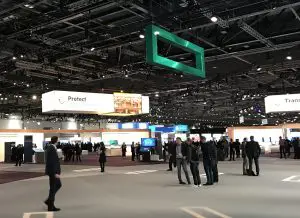 While HPE typically uses Discover to announce its latest and greatest, news from HPE Discover in London this year included the names of several other vendors. It was a year of partnerships for the company. But that comes after the company has a lot of explaining to do. The blogger sessions that I took part in, it was clear that a lot of explanation was needed concerning the “spin-merge” of Enterprise Services out with CSC and the sale of its software application assets to MicroFocus.
While HPE typically uses Discover to announce its latest and greatest, news from HPE Discover in London this year included the names of several other vendors. It was a year of partnerships for the company. But that comes after the company has a lot of explaining to do. The blogger sessions that I took part in, it was clear that a lot of explanation was needed concerning the “spin-merge” of Enterprise Services out with CSC and the sale of its software application assets to MicroFocus.
